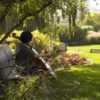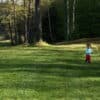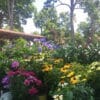
(photo by Steve Jonas)
This stone arch, created by participants in our 2007 Vermont Stone Workshop, captures a mouse-hole view of our pond.
When you shrink the size of an opening, what’s behind it seems to become more significant. It’s the same effect as when you look through a telescope or a porthole on a ship: the world is reduced to just what’s inside the frame. Because the frame is small, you contemplate what’s in view and notice every detail. This effect works best with a limited number of openings in an otherwise solid wall. A form of the hide-and-reveal idea (see page 148 in Home Outside), mouse-holing is a little like playing peek-a-boo with the viewer: Now you see it (the view), now you don’t. You can use a mouse-hole as a kind of tease, giving little tastes along the way until the whole opens up to view at a wider vantage point. If you can actually walk through a mouse hole, the effect becomes even more powerful.
(photo by Randy O’Rourke)
The entry to our house has a strong “mouse-hole effect,” drawing the visitor in toward the light and the view. The deep purple wall contrasts strongly with the bright southern light in the dining room beyond.
From Home Outside: Creating the Landscape You Love by Julie Moir Messervy (The Taunton Press, 2009).







Join the discussion One Comment